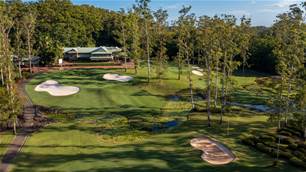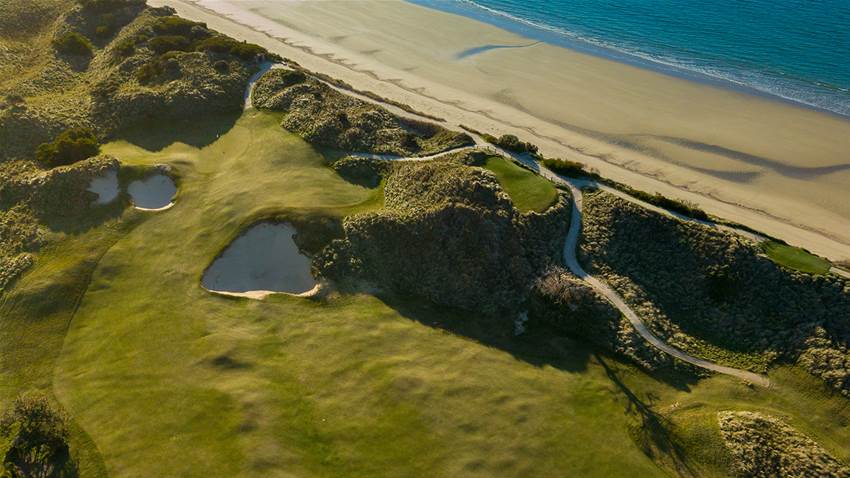At the heart of all great short par-4s is the interesting choice to be made on the tee. As a rule, if you decide to eschew the challenge and play the ‘easy’ tee shot the pitch will be pretty demanding. It works the other way too.
BONNIE DOON GC
293-metre, 12th hole
Walking up onto the tee brings the Sydney CBD skyline into view, off into the distance to the left. To the right and below, lies the 12th hole that asks several questions of shot and club choice before you have even made a swing. The smart play is a long iron to the bottom of the hill and short of the fairway bunkers will leave you a short approach into a wide green.
BONNIE DOON GC
310-metre, 16th hole
From this elevated tee players can choose two playing lines to the green. The longer hitter will want to take driver over the scheme of fairway bunkers on the right and leave a short wedge into a small narrow and bunker-protected green. Shorter hitters should play to the fat of the fairway and attack the green from there.

BONVILLE GOLF RESORT
331-metre, 2nd hole
While this hole can be played from the 346-metre back markers, many of our judges felt the risk-and-reward of pegging up from the white markers (331 metres) made this very good hole just a little better. Played across the slope of a hill from an elevated tee to a fairway heavily lined by tall flooded gum trees, the hole turns right around a bunker and up to a green terraced into the side of a hill.
CONCORD GC
266-metre, 13th hole
This is rated No.18 on the Concord scorecard but, as a result of a Tom Doak redesign that opened for play in 2018, it is one of the most fun to play. From the tee, long drivers can reach the large horseshoe-shaped green, which wraps around a small deep bunker that should be avoided at all costs. The key for the rest of us is to leave your approach on the correct side of the green to have any chance with the putter, but this is reliant on finding a good position off the tee.
COOLANGATTA & TWEED HEADS GC – RIVER COURSE
314-metre, 13th hole
Standing on the 13th tee there is only one question the hole asks of you: “Can you hit the fairway?” Missing the narrow fairway, heavily lined by trees and scrub, offers little respite or chance of making par. From the fairway, the approach to the deep, narrow and elevated green is treacherous as the wind off the river can push these high-flying shots wide of the target.

EASTLAKE GC
249-metre, 14th hole
Known as the ‘Big Dipper’, the 14th is shorter than most holes featured here but it plays slightly longer than its 249 metres because most of the journey to the green is uphill. A fairway bunker, left and well short of the green, can catch longer drives, while shorter drives will leave a semi-blind approach to the elevated green.
ELLERSTON
308-metre, 8th hole
The shortest par-4 at Ellerston presents a blind tee shot over the crest of a hill and it is important to select the right club for the shot. A driver can see your ball run through the end of the fairway and into a deep, grassy ravine short of the green. There are seven bunkers surrounding the putting surface, with short and right being the only ‘good’ miss.
MONASH CC
315-metre, 13th hole
The huge bush rock in the centre of the fairway provides players a platform from which to hit their approach shots to the green below. The aggressive line is well left of the Bahai Temple (on the hill in the distance) and over trees left of the fairway, which will leave a short pitch to the green.
MONASH CC
314-metre, 18th hole
Recently renovated, the 18th provides a spectacular finish where your tee shot is played across a waterfall to a sloping fairway with tall overhanging trees left and bushland to the right. The green is protected by sand left and right so correct club selection for an approach from well below the green is challenging.
MOORE PARK GC
310-metre, 12th hole
Played from an elevated tee to a narrow fairway, the tee shot is all about club selection. Go to long and you can run out of fairway, as it veers left and then right around a massive bunker. The green features a huge tier and leaving your approach shot on the wrong level will make birdie, or par, unlikely.

NAROOMA GC
330-metre, 2nd hole
The cliff-top par-3 3rd hole quite rightly grabs all the headlines at Narooma, but the journey to reach that hole is just as spectacular. The tee is perched high above the start of the fairway, which climbs gradually and bends left around the cliff top. Anything from a long iron to a wedge may be needed to cut across the bend, and a deep bunker, to hit the putting surface. Taking the safe route to the right of the green can also find a bunker well short.
NEW SOUTH WALES GC
323-metre, 14th hole
The 14th is a beautiful natural hole that could not be reproduced anywhere else in the world. Your drive must carry the impenetrable shrub gully that lies between the tee and fairway, which sits at a 45-degree angle to the approach of your ball and features a high mound traversing the fairway. From here there is no margin for error and the pitch up to the small green is arguably the most demanding shot you’ll face inside 100 metres.
NEWCASTLE GC
326-metre, 11th hole
The 11th gives the impression of being easy as you stand on the tee. From a tee enclosed by trees, the hole opens up as it gently rolls toward the green. A fairway bunker well short of the green, and set near the right edge of the fairway, can be easily found as the rolling short grass feeds balls into it and will, ultimately, lead to a hard-fought par, bogey or worse.
RANDWICK GC
330-metre, 2nd hole
Location, location, location … this can be just as important for golf as it is for real estate. Randwick is a short par-54 course and its little 2nd hole is simple yet exciting to play. Played along the edge of a cliff with uninterrupted ocean views, the fairway cambers left toward the water as the hole veers slightly right up to a small, bunkerless green.
ROYAL CANBERRA GC
289-metre, 7th hole
Played slightly uphill from the edge of Lake Burley Griffin, the left side of the wide fairway is the best route to the green, but a carefully placed bunker adds an element of risk. An approach from the right of the fairway is difficult to get close to most pin positions here.
SHELLY BEACH GC
333-metre, 6th hole
The spectacular seaside setting – where the left edge of the fairway is separated from the beach by scrub-covered dunes which are out-of-bounds – leaves this par-4 well-exposed to the wind. The fairway rolls gently south and can play much longer when the wind is up, but this takes a shallow fairway trap and some encroaching trees out of play for many.

ST MICHAEL’S GC
340-metre, 14th hole
A redesign of this hole in recent years has made this a much better hole. The addition of fairway bunkers right of the gently rising fairway and the exposing of sandy wasteland left and closer to the green makes you think more about your strategy for the hole. Into a strong wind, the second shot for many players is a blind one.
STONECUTTERS RIDGE GC
320-metre, 5th hole
Plenty of questions asked on the tee here. The wide fairway is flanked by wetlands to the right and is pinched in by fairway bunkers left and right of the landing zone. The conservative play is to lay up short of the bunkers and head for the green over the edge of the hazard. It is a narrow entry into the green, which is surrounded by three bunkers and lots of short grass to feed mis-hits away from the putting surface.
THE AUSTRALIAN GC
319-metre, 3rd hole
A lake is the key feature of this hole. The water hazard cannot be seen from the tee and can be reached by longer hitters, especially downwind. There are two fairway bunkers right and these need to be skirted to get the best possible line into the two-tiered green, which sits obliquely to your approach and slopes toward the water on the lower level.
Related Articles

Review: Omaha Beach Golf Club

Drinks With... Ricky Ponting







_15th_hole.jpg&h=115&w=225&c=1&s=1)




